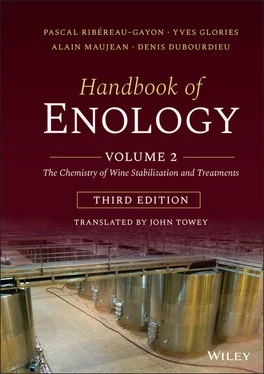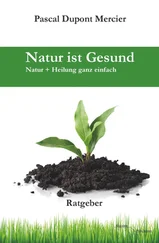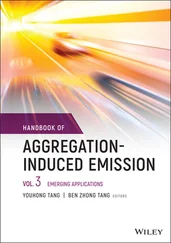7 Chapter 7FIGURE 7.1 The main monoterpenes and derivatives identified in grapes and wi...FIGURE 7.2 Cyclic terpene derivatives identified in wine.FIGURE 7.3 Illustration of chemical transformation and biotransformation phe...FIGURE 7.4 Formation of “wine lactone” from ( E )‐2,6‐dimethyl‐6‐hydroxyocta‐2...FIGURE 7.5 The various forms of terpene glycosides (or norisoprenoids) ident...FIGURE 7.6 Breakdown of carotenoids leading to the formation of C9‐, C10‐, C...FIGURE 7.7 Main families of norisoprenoid derivatives in grapes (C13‐norisop...FIGURE 7.8 Formation pathways of β ‐damascenone in grapes and wine (G = ...FIGURE 7.9 Mean intensity of the “vegetal” descriptor in red wine supplement...FIGURE 7.10 Correlation between the “green pepper” character identified duri...FIGURE 7.11 Distribution (%) of IBMP in various parts of Cabernet Sauvignon ...FIGURE 7.12 Aromatic volatile thiols of varietal origin identified in wines:...FIGURE 7.13 Thiopyrroles identified in wines and presenting roasted and gril...FIGURE 7.14 The cysteine conjugate form of 3‐mercaptohexanol (3‐sulfanylhexa...FIGURE 7.15 S ‐conjugate precursors of volatile thiols identified in Sauvigno...FIGURE 7.16 Distribution of cysteinylated and glutathionylated precursors of...FIGURE 7.17 Formation of volatile thiols from their cysteinylated precursors...FIGURE 7.18 Keto–enol equilibrium of homofuraneol.FIGURE 7.19 Correlation between the distinctiveness or typicity level of swe...FIGURE 7.20 Various compounds identified in V. labrusca and V. rotundifolia ...
8 Chapter 8FIGURE 8.1 Acetaldehyde in the bound state with aliphatic and cyclic acetals...FIGURE 8.2 Different activated forms of oxygen.FIGURE 8.3 Cascade of chemical reactions involving oxygen and leading to the...FIGURE 8.4 Reaction sequences for the conversion of glycerol into acrolein b...FIGURE 8.5 Volatile phenols responsible for “phenolic” off‐odors in wine.FIGURE 8.6 Comparison of (a) vinylphenol concentrations in white wines and (...FIGURE 8.7 Wines classified according to their volatile phenol concentration...FIGURE 8.8 Decarboxylation of phenolic acids in must by S. cerevisiae during...FIGURE 8.9 Vinylphenol formation mechanism in must clarified using a pectina...FIGURE 8.10 Specific effects of various A. niger esterases in commercial pec...FIGURE 8.11 Impact of the strain of winemaking yeast on the vinylphenol conc...FIGURE 8.12 Example of changes in the ethylphenol concentration of a red win...FIGURE 8.13 Enzyme mechanism for the production of ethylphenols by Brettanom ...FIGURE 8.14 Relationship between the free SO 2and ethylphenol concentrations...FIGURE 8.15 The main compounds responsible for cork taint (Amon and Simpson,...FIGURE 8.16 Bacterial transformation of vanillin from cork into guaiacol.FIGURE 8.17 Transformation of a chlorophenol into chloroanisole.FIGURE 8.18 Complete biosynthesis of 2,4,6‐trichloroanisole (Maujean et al .,...FIGURE 8.19 Chemical structure of silicones used to coat corks. (a) Nonreact...FIGURE 8.20 Formulas for the main “light” and “heavy” sulfur derivatives (Ta...FIGURE 8.21 Reduction of sulfates with production of sulfur dioxide, hydroge...FIGURE 8.22 Formation of methionol from methionine (Ehrlich reaction).FIGURE 8.23 Fixing sulfur derivatives (methanethiol, R = CH 3; ethanethiol, R...FIGURE 8.24 (a) Formation of thiocarbamic acids from dithiocarbamates. (b) T...FIGURE 8.25 Structure of lannate, an active ingredient in certain insecticid...FIGURE 8.26 Acephate hydrolysis mechanism (Rauhut et al ., 1986).FIGURE 8.27 Lannate hydrolysis mechanism.FIGURE 8.28 Disulfide and trisulfide formation by oxidation–reduction in the...FIGURE 8.29 Maillard reaction involved in the nonenzymatic oxidative brownin...FIGURE 8.30 Maillard reaction involved in the appearance of sulfur derivativ...FIGURE 8.31 Photochemical reduction of riboflavin involved in lightstrike.FIGURE 8.32 Sequence of reactions involved in the development of lightstrike...FIGURE 8.33 2‐Aminoacetophenone.FIGURE 8.34 2‐Aminoacetophenone formation pathways.FIGURE 8.35 Methional (1), phenylacetaldehyde (2), and 3‐hydroxy‐4,5‐dimethy...FIGURE 8.36 Keto–enol tautomerism of 3‐methyl‐2,4‐nonanedione.FIGURE 8.37 Examples of 3‐methyl‐2,4‐nonanedione (MND) contents in a great w...FIGURE 8.38 Formula for ()‐geosmin.FIGURE 8.39 Enzyme reduction of 1‐octen‐3‐one to 3‐octanone by S. cerevisiae FIGURE 8.40 Chemical breakdown of 2‐methylisoborneol by chemical dehydration...FIGURE 8.41 Transformation of sorbic acid by lactic acid bacteria.FIGURE 8.42 Tautomeric forms of 2‐acetyltetrahydropyridine, assumed to be re...FIGURE 8.43 Appearance of a bitter almond off‐odor due to the formation of b...
9 Chapter 9FIGURE 9.1 Diagram of colloidal transformations.FIGURE 9.2 Distribution of charges in a double layer around a charged colloi...FIGURE 9.3 Simulation of the impact of salt concentration (C 1< C 2< C 3) on ...FIGURE 9.4 Diagram of the flocculation of a hydrophilic colloid by eliminati...FIGURE 9.5 Two‐stage mechanism by which tannins precipitate proteins (galloy...FIGURE 9.6 Model of the colloidal properties of flavanols (tannins) (Saucier...FIGURE 9.7 Various mechanisms by which polysaccharides protect colloidal par...FIGURE 9.8 Flocculation by bridging of two colloidal particles in the presen...FIGURE 9.9 Depletion phenomenon accounting for the precipitation of colloida...
10 Chapter 10FIGURE 10.1 End of a plunger for adjusting the volume of lees left at the bo...FIGURE 10.2 Influence of the racking method on aeration of the wine: (a) no ...FIGURE 10.3 Diagram of the flocculation mechanism of proteins in wine during...FIGURE 10.4 Diagram of the double layer of a charged particle and the electr...FIGURE 10.5 Changes in electrostatic potential in the vicinity of a double l...FIGURE 10.6 Particle charge detector measuring system (Lagune, 1994).FIGURE 10.7 Mechanisms operating in the solution of a positive species durin...FIGURE 10.8 Measurement cell for zeta potential.FIGURE 10.9 Determining the surface charge density of a negative species by ...FIGURE 10.10 Titration of a red wine with polyDADMAC polyelectrolyte (Lagune...FIGURE 10.11 Changes in the streaming potential of a wine according to the v...FIGURE 10.12 Modeling the fining of a red wine with gelatin using a surface ...FIGURE 10.13 Various methods for mixing fining agents into wine: (a) in a ta...FIGURE 10.14 Flake structure of montmorillonite (bentonite). (T, tetrahedron...FIGURE 10.15 Polymerization of vinylpyrrolidone into (a) polyvinylpyrrolidon...
11 Chapter 11FIGURE 11.1 Graph of t / V = k 2 t + 1 /q 0.FIGURE 11.2 Graph of t / V = k 3 V + 1/ q 0.FIGURE 11.3 The filtration mechanism(a) Surface deposit: the solid parti...FIGURE 11.4 Structural unit of the glucan molecule in B. cinerea (or cinerea...FIGURE 11.5 Effect of glucan from B. cinerea on pad filtration (Dubourdieu, ...FIGURE 11.6 Effect of adding various doses of glucanase SP 116 during fermen...FIGURE 11.7 Diagram of a 4‐l test chamber capable of withstanding up to 7 ba...FIGURE 11.8 Diagram of the circuits in a diatomaceous earth pressure leaf fi...FIGURE 11.9 Schematic diagram of a plate‐and‐frame filter: 1, piston pump; 2...FIGURE 11.10 Cross‐section diagram of a rotary drum filter, used for must or...FIGURE 11.11 Cellulose pad filter, (a) without and (b) with reversing chambe...FIGURE 11.12 Diagram of a system used to determine filtration characteristic...FIGURE 11.13 Lenticular filter. Vessels fitted with (a) one module and (b) f...FIGURE 11.14 Schematic diagram of tangential filtration: 1, inlet of liquid ...FIGURE 11.15 Diagram of a continuous centrifuge with automatically opening b...FIGURE 11.16 Section diagram of a centrifuge disc: 1, inlet of liquid to be ...
Читать дальше












